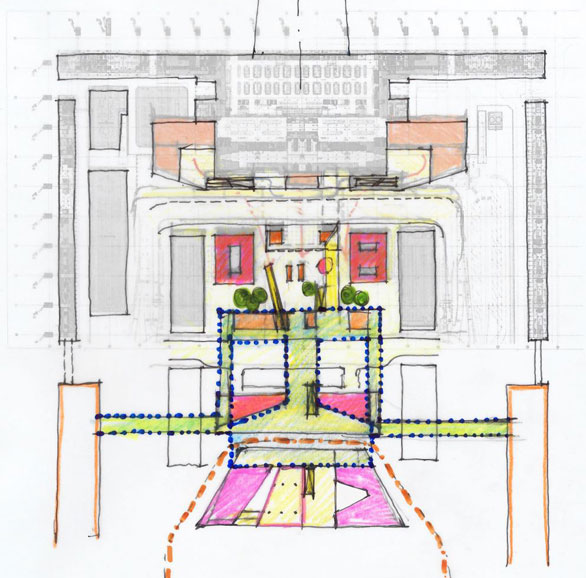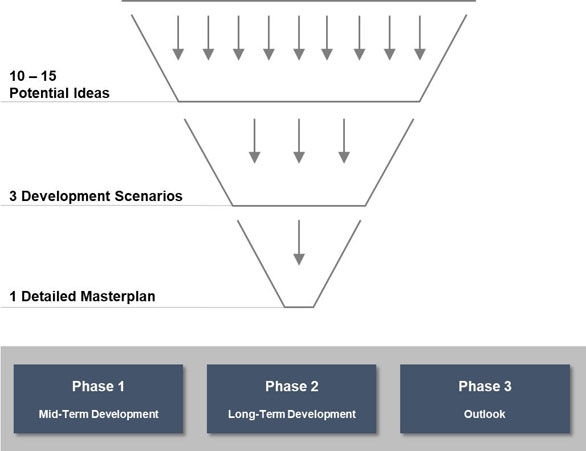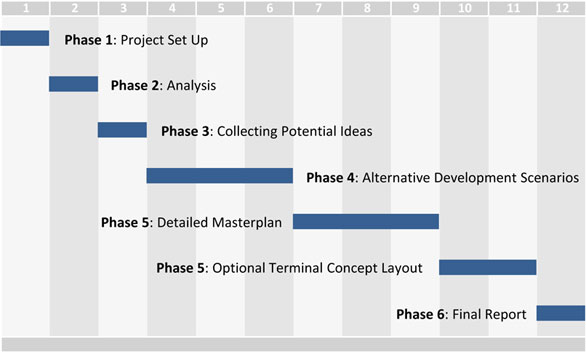


For the longest time, the question of business growth in the airport industry seemed to answer itself. Demand for air travel has grown continuously over the last decades. Many airport operators treated infrastructure planning as a simple linear equation: more potential passengers = more required square-meters of building and aprons = more potential revenue. The challenges of such masterplanning projects were regarded as those common to all infrastructure expansion projects – requiring thorough planning, sure, but they were a known quantity.
Perhaps that is why, over the past ten years, I have seen so many clients surprised and exasperated when realizing the full scope of their masterplan project. But then, treating development strategy for airports as an engineering challenge – x more passengers require y more check-in desks, etc. – is to underestimate the complexities and inevitable conflicts inherent to the endeavor.
After all, air travel is a highly volatile industry – despite its continuous growth. Indeed, this is one of the industry’s true paradoxes: the economic, political and regulatory context in which airports do business is subject to rapid shifts, involving many unknowns. Infrastructure projects, on the other hand, are as long-term as it gets.
For one, government support – not just financially – is no longer a given and dependent on current policy; some administrations might even actively seek to limit airport capacities, regardless of consumer demand. Nor is continuous infrastructural expansion an option where major airports start to lack available space, e.g. in Frankfurt and Dubai. Even for players with ample room for new developments, complex political and legal requirements are flanked by other vital business decisions – e.g. whether to service budget airlines with a dedicated infrastructure or how to include more commercial area. The potential outcomes point towards very different ways of harnessing revenue streams as part of long-term strategic planning.
And, last but not least, in the last years airports became subject to the same disruptive innovations that change our lives elsewhere. Digitisation impacts everything: from making check-in staff redundant to slashing parking revenue from car sharing, Uber and, in the future, self-driving cars.
Airport development concerns investment decisions amounting to several million Euros. But as more and variables and unknowns enter into the picture, decision-making needs to take into account much more than just the cost projections of infrastructure expansion. Rather, we believe that masterplanning needs to be treated as a central tool of business strategy – and, just like business strategy, it needs to take look at the full picture: evaluating potential options on the basis of economic, strategic, technical and operational concerns. That is why we propose a holistic and iterative process, rather than the linear model that is common to engineering challenges.
Note here that we say options plural: where traditional planning processes funnel resources into one “sacred idea,” masterplanning always involves elaborating various scenarios. In these scenarios, we render as many variables and unknowns concrete and, importantly, do business model testing for each of them. That way, we empower airport management to create opportunity out of complexity.
Our strategic masterplanning process on average takes around 8 – 12 months and is divided into six distinct phases. Each of these phases concludes with interim results and first decisions; these are presented to all stakeholders in a workshop setting so as to ensure everyone remains on board with the progress.
First, we familiarize ourselves with the project goals and requirements. To gain a better understanding of client needs and desires, we arrange for individual, in-depth sessions with key stakeholders. Presenting our preliminary findings to the airport management, we arrive at a joint understanding of the project.
In the following kick-off workshop involving both management and the extended stakeholder circle, we get everyone on board with the goals and process agreed on during the initial round of consultation with management. All participants are invited to share their priorities and expectations. Acting as facilitators, we set the stage for people to enter into the process in a collaborative spirit.
In our experience, approximately 50% of project stakeholders will not have been involved in a masterplanning process before. To get everyone on board, we bring hands-on examples from other masterplans to our kick-off workshop, explaining the process and results. With the help of best practice examples, we create a solution-focussed mindset in the group.
Timeframe: 2-4 weeks
Objective: Gain a common understanding of the project goals and process between all masterplan-stakeholders
In the analysis phase we look into four separate topics:
The analysis of status quo includes a summary of the airport’s current infrastructure, e.g. gross floor areas of buildings, information about their age and condition. Additionally, we set up an overview of the existing airport capacity: number of aircraft stands, gates, check-in counter etc. This list also contains information about existing process times. If the airport does not have information about process times, we arrange for it to be measured.
The capacity demand analysis is based on the traffic forecast for the airport. We break down the traffic numbers to peak hour demand and calculate the future capacity demand figures for each process and for each of the intended development phases in the masterplan. The difference between existing capacity and future demand per peak hour results in the capacity gap which has to be solved by the masterplan.
The aim of the airport industry future trends overview is broaden up the horizon of all stakeholders. It delivers the basis for a “what if“ discussion: what would it mean for our airport if all cars were be self-driving in 15 years? How would the infrastructure demand change? What would this mean for revenue?
Finally, we conduct a set of strategic options for the client, in which we conclude all the information gained in the Analysis Phase. The result is presented and discussed with the management and the key project members of the client in a strategy workshop.
Timeframe: 1-2 month
Objective: Gain a holistic understanding of all relevant framework conditions and the future strategic options of the airport
Having aligned goals and expectations with everyone during the first two project phases, we launch into the project’s main phase of iterating solutions. We collect all potential ideas and solutions, including even scenarios that one might be tempted to dismiss immediately. Project understanding and trajectory will evolve a lot over the process; it is important to keep an open mind. In our last masterplan project for example, we sketched up 15 ideas how the airport could develop within the next 25 years. This includes solutions which seemed highly unrealistic or futuristic. However, for the decision process it is important to discuss even these kind of ideas. To prove that “everything thinkable was taken into consideration“ it is crucial to get the acceptance from all stakeholders for the options chosen for further processing.
Timeframe: 1 month
Objective: Identifying three ideas for further testing, picked from the full set of opportunities

The three most promising ideas are translated into comprehensive development scenarios. We prototype and quickly refine these business cases by testing their viability vis-à-vis internal/external variables and potential disruptors. Each scenario consists of a plan showing how the airport might look at the end of the masterplan period, as well as a corresponding capacity calculation model and a basic business plan model.
Indeed, developing, testing and comparing several models at the same time is a vital advantage in the decision-making process, especially where this is backed up by economic projections. Yet, it is also one of the key ways in which strategic masterplanning differs from linear, engineering-driven expansion plans: it looks at a variety of possibilities from a business perspective and not just as a technical challenge.
We cannot stress enough how important it is to include such a business plan model. Rating development options only with construction cost estimates simply does not deliver sufficient information for strategic decisions. Taking into account the revenue side of a potential development will help stakeholders to find the best compromise between their infrastructure wish-list and what is feasible.
Timeframe: 2-3 months
Objective: Identifying the best strategic model among the three prototyped scenarios on the basis of qualified evaluation
The solution that is found to be most viable is translated into clear, actionable steps and prepared for implementation. This includes
Timeframe: 2-3 month for detailed masterplan and 1-2 month for terminal concept layout?
Objective: Formulating the airport’s comprehensive Masterplan

The results of the masterplan process is summarized in a final report. Usually this consists of 3 separate documents with different level of detail:
The first key task of phase 6 is communication of the results to all internal and external parties. The second task is to set up a first organizational concept for the implementation of the masterplan results: project teams, budgets, time schedules. Very often, the board of the airport will only approve the masterplan results when they understand exactly what this means from an organizational side.
Timeframe: 1 month
Objectives: communication of the results to all internal and external parties. Set up a first organizational concept for the implementation of the masterplan results: project teams, budgets, time schedules. (Very often, the board of the airport will only approve the masterplan results when they understand exactly what this means from an organizational side)

Masterplanning is a highly adaptive framework; the specifics and content of various projects can differ quite profoundly. Nonetheless, our experience shows that there are several baseline requirements for the process to achieve its goal.
Top management needs to be willing to devote time and resources to the masterplanning process – ideally, they will even be happy to do so, giving masterplanning the attention it deserves as the vehicle for their longer-term strategic goals. Over the course of the project, there are various ways for management to pull its weight. Firstly, it can help to keep up momentum among stakeholders: making sure the importance of the project is known to all, checking in regularly on progress, and creating “positive pressure” by requesting results. Equally important is decisiveness: top managers need to make clear decisions – for as much as against possible paths or solutions – knowing that these will clash with some stakeholders’ interests. Finally, top management also takes care of information flow with supervisory boards etc.
In our experience, strategy processes like masterplanning only reach ideal efficiency when they are treated as separate from the operational side of things. In the early stage of the project, monthly full-day workshops with members from management present might be supplanted with individual meetings, but as the process goes on, those day-to-day meetings should be reduced to a minimum. The main “playground“ for the masterplan should be in workshops. This promotes transparency, open debate, and ensures that all project members have a shared understanding/frame of knowledge.
The core team is made up of 5-7 representatives from client and consultancy side each. Needless to say, this presents some political difficulty. Some stakeholders are bound to feel excluded, but the priority should lie with bringing in representatives from the most important departments. Again, conflicts are likely to arise even when representatives are chosen – internal stakeholders from different departments might not have had to collaborate in such way and wonder what holistic strategy planning means for their future. However, as experienced facilitators, we are able to anticipate and mediate these concerns within an intelligent process. Additionally, we make sure that there is a feedback/communication protocol in place for stakeholders outside the core team and that people are still kept engaged and in the loop thanks to regular updates.
Time and again, we come up against questions and issues within the process that aren’t covered by the scope of work originally agreed upon. To avoid frustration on both sides, it is vital to agree at the outset which topics are to be covered by the masterplanning process: if economic viability is a priority in one project, then it follows that we will include a project business plan. Nonetheless, any iterative process requires both parties to remain flexible; to accept that exact content/deliverables may change so long as they still correspond to the original agreement. We aim to provide as holistic a scenario as possible – in our experience, breadth of content here is preferable to depth.
Rushing through a masterplanning process is risky indeed. Holistic strategy development requires careful planning and analysis; after all, it concerns decisions that impact the long-term future of the airport and that carry a hefty price tag. However, it’s important to note that avoiding or putting off decisions is no less precarious. The most risky projects we personally have experienced were those with no deadline pressure whatsoever – if masterplanning drags on too long, project members will lose faith in the process, which only further stalls a project that concerns nothing less than the future of the organization. And there is nothing that paralyses and organization more than the lack of a future vision.
